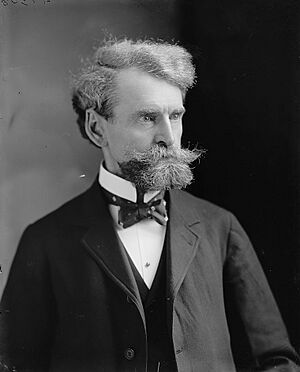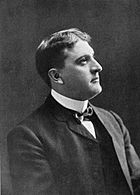Copper Kings facts for kids
The Copper Kings were three powerful business leaders: William A. Clark, Marcus Daly, and F. Augustus Heinze. They were famous for their huge rivalries in Butte, Montana. These fights happened during the Gilded Age, a time of great wealth and change. The men battled for control of the local copper mining industry. Their struggles affected not only Montana but also the entire United States.
The battles between Clark, Daly, and Heinze, and later between Heinze and big investors William Rockefeller and Henry H. Rogers, are a major part of Montana's history. Eventually, Daly’s original company, Anaconda Copper, became a monopoly. This means it controlled almost all the copper mining. By the late 1920s, Anaconda Copper was the fourth largest company in the world.
History of Copper Mining in Montana
After the American Civil War, it was expensive to melt down copper ore. But investors like William Andrews Clark and Andrew Jackson Davis saw potential. They started to develop mines in Butte. They also built factories to get silver and gold out of the ground. The riches found in the hills made Davis Montana's first millionaire.
By 1876, Butte was a busy silver town with over 1,000 people. Marcus Daly arrived that year. He was working for the Walker brothers, who were business people from Salt Lake City. Daly's job was to check out the Alice Mine for them. Daly bought the mine and managed it very well for the Walkers. The town of Walkerville, which you can still see near Butte, grew up around this mine and others.
In 1880, Daly sold his share in the Walkers' mines. He then bought the Anaconda Mine. He got money for this from several investors in San Francisco. These included James Ben Ali Haggin, Lloyd Tevis, and George Hearst. George Hearst was the father of the famous media owner William Randolph Hearst. Other investors from Denver and the East also came to the area. Soon, people with money from New York City and Boston also invested in Butte's huge potential.
During the 1880s, copper mining became the most important industry. Butte became the world's biggest producer of copper. The Utah and Northern Railway reached the area in 1881.
Butte soon started to pay a price for its wealth. The air became filled with bad, smoky air from the mines. Daly responded by building a giant smelter in Anaconda. A smelter is a factory that melts ore to get the metal out. This smelter was about 30 miles west of Butte. Even today, its giant smokestack is a famous landmark. Soon after Daly built his smelter, the Boston and Montana Co. built one in Great Falls. This company had the second-largest mining operations after Daly's. Daly later built his own railroad to carry ore from his mines to his smelter. Trains carried the ore from Butte's mines to both smelters.
The Copper Kings' Rivalries
William A. Clark also wanted to be an important political leader. He used his newspaper, the Butte Miner, to help his political dreams. He became popular in Helena, Montana, by supporting it to become the state capital. He campaigned against Anaconda becoming the capital. Clark's long-time dream was to become a United States senator. In 1899, he faced problems when trying to get votes from the Montana State Legislature. At that time, U.S. Senators were chosen by state lawmakers. The U.S. Senate did not allow Clark to join because of these issues. However, he later ran another Senate campaign and won. He served one term from 1901 to 1907.
In 1899, Marcus Daly joined with two leaders from John D. Rockefeller's Standard Oil. These were William Rockefeller and Henry H. Rogers. Together, they created the huge Amalgamated Copper Mining Co.. This was one of the largest business groups of the early 1900s. (It's important to note that Standard Oil and John D. Rockefeller himself were not directly involved). To make things even more exciting, another Copper King, F. Augustus Heinze, fought against Amalgamated's control. This added a lot of drama to Montana's legal history.
Marcus Daly passed away in 1900. John D. Ryan, a local banker, became close to Margaret Daly after her husband died. He eventually convinced Heinze to sell his mining interests. This helped Amalgamated achieve its goal of becoming a monopoly. By 1910, the company changed its name to the Anaconda Copper Mining Company. It bought up many smaller mining companies along the way. The Anaconda Company controlled Butte for the next 74 years.
See also
 In Spanish: Reyes del Cobre para niños
In Spanish: Reyes del Cobre para niños




